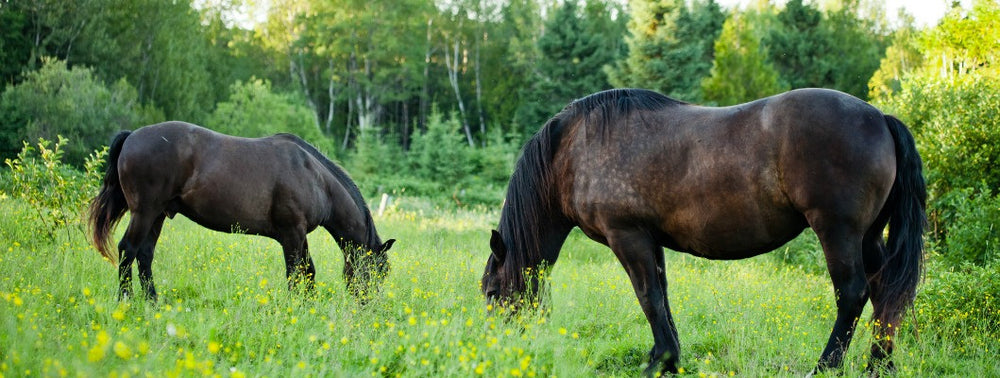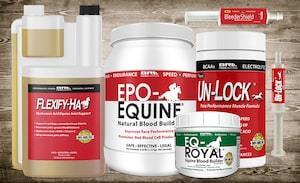
Your horse is anxious to get on that beautiful spring grass. But, hold onto your horses (just couldn't resist)! That grass might pose a healthrisk to your horse.
If your horse is high-risk for founder, or if you're just an overprotective parent, then prevention is key when it comes to spring grass. With the following tips, you can avoid risk and enjoy spring without any vet visits (or bills).
High Risk Factors
There are certain risk factors that dictate whether or not you should limit your horse's exposure to new grass, including:
- Your horse has a history, or medical diagnosis, of laminitis or founder.
- Your horse is overweight or medically obese.
- Your horse has been diagnosed with a predisposition to disease, such as Cushing's Disease or insulin and glucose issues.
Tip: If you’re not sure if your horse is high-risk, call your vet and ask for an exam. The cost beats paying for future problems, and it will put your mind at ease, too.
Pasture Management
A well-managed pasture is your first line of defense against founder risk. If you don't know much about pasture management, here are some tips:
- Cut regularly and eliminate weeds. Horses often eat overgrowth that can put them at higher risk. Some weeds can contain more sugar than grass. Weed management is best for prevention. A crop specialist can identify weeds and determine what will work best in your pasture.
- Fertilize regularly. Without the proper amount of nitrogen, grass growth is limited, and sugar growth is encouraged. If you don't want to tackle fertilization, contact a crop consultant for help. The cost of a crop consultant is usually comparable to a plumber's fees. But remember: It's a one-time investment that might help you save on vet bills, and even hay, in the future.
- Consider testing. Contact your state's agricultural specialist for instructions on testing your pasture. Testing can determine what your pasture needs, including the proper amount of chemicals and how often testing should be done. That will mean less stress on you. In most cases, testing is free, but contact your local office and ask.
Grass supplied with the proper nutrients grows better, and its sugar content is more stabilized. It might even mean you can buy less hay in the future. And that's a big deal with the high cost of hay!
Why Temperature Matters
When there's full sunlight and temperatures are between 20º F and 40º F (F , sugar concentration in spring grass increase. When temperatures fall below 20º F, grass sugar levels decrease.
So, get a good outdoor thermometer; when the temperature is falls within the elevated range, keep your horse off the grass.
Rotational Grazing and Avoidance
When it comes to avoiding grass with high sugar content, prevention is your best strategy. The best line of defense is to limit your horse's consumption. Here are some tips:
- Only allow your horse to graze a few hours per day; your vet can advise the best number of hours.
- Avoid late-afternoon grazing on a sunny day. After a full day of sun, sugar levels may be at their highest.
- When possible, allow grazing in shaded areas.
- Even brown and frozen grass can contain sugar. Before allowing your horse unlimited access on these grasses, consult a crop specialist and your vet. They can test to determine levels, then advise what’s best.
- Avoid lush areas of pasture when possible.
- When in doubt, a muzzle can limit the amount of grass your horse consumes. And with so many styles on the market now, it's easier than ever to find one that works.
Regular Routine
Most horses like regular routines. Depending on your schedule, plan one and stick with it.
Here are a few ideas that work well:
- Allow your horse to graze from 8:00 a.m. until noon.
- If rotating days work best for your schedule, you can try one or two days on grass, and then keep them off for 24 to 48 hours.
- Your horse's risk level and current health may determine hours allowed on.
No matter what routine fits your schedule and needs, check with your vet first. He or she can decide what's best for your horse's health and circumstances.
Rotational grazing, proper pasture management, testing and a good plan can all work toward happier and healthier spring grazing. And armed with the right knowledge and a plan, you and your horse can enjoy the pleasures of spring.
What's that saying about an ounce of prevention?
Top trainers, owners and competitors rely on BRL Equine products to help their horses perform at their very best. You can get the same great results! Our all-natural equine nutritional supplements really work... guaranteed or your money back!





Also in Horse Tips and More
Top 10 Ways to Show Your Horse You’re Thankful For Him
November 01, 2021
View full article →
5 Ways to Prepare Your Barn For Summer
May 03, 2021
View full article →
Your New Spring Horse Health Checklist
March 12, 2021
View full article →